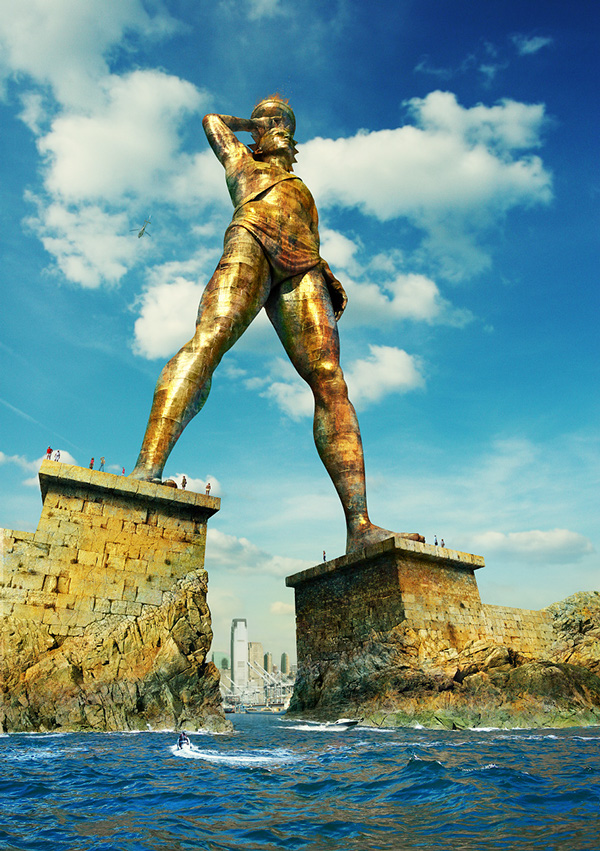The Colossus Of Rhodes Greece
Have you ever heard about the Colossus of Rhodes? Well, let me tell you about this Greek Wonder of the Ancient World. It was a statue of the god Helios, erected in the city of Rhodes in Greece. According to historical accounts, the statue stood over 30 meters (98 feet) tall, and it was one of the tallest statues of the ancient world. It was so big that ships could sail beneath its legs!
The Colossus of Rhodes was built to celebrate the victory of the people of Rhodes over the army of Demetrius Poliorcetes in 305 BC. The statue took 12 years to build, under the supervision of the sculptor Chares of Lindos. It was made of bronze and iron, and it stood on a marble pedestal.
Unfortunately, the statue didn't last for long. In 226 BC, the island of Rhodes was hit by an earthquake, and the Colossus fell down. Despite the damage, the statue remained on the ground for over 800 years, until Arab invaders melted it down in 653 AD, to make weapons.
The Colossus of Rhodes may no longer exist, but its legacy lives on. The statue inspired other artists and architects throughout history, and it became a symbol of the power and grandeur of the Greek civilization. Today, people all over the world still marvel at the idea of the Colossus of Rhodes, and they long to see it rebuilt.
History
The history of the Colossus of Rhodes is a fascinating one. It all started with the victory of the Rhodians over Demetrius Poliorcetes, a general of the Macedonian king. As a token of gratitude to the sun-god Helios, who was believed to have helped them win the battle, the Rhodians decided to erect a huge statue in his honor.
The statue was designed and built by Chares of Lindos, a famous sculptor of the time. It was made of bronze and iron, and it stood on a base of white marble. The construction of the Colossus took 12 years, and it involved dozens of workers and artisans.
The statue was a true wonder of the ancient world. It stood over 30 meters (98 feet) tall, and it depicted the god Helios with his arms raised up, as if he was blessing the city of Rhodes. The Colossus was so big that ships could sail beneath its legs, and the people of Rhodes used to boast that it was one of the wonders of the world.
Unfortunately, the Colossus of Rhodes didn't last for long. In 226 BC, the island of Rhodes was hit by a powerful earthquake, and the statue fell to the ground. Some sources claim that the Colossus remained intact for over 800 years, and that people used to visit the ruins and marvel at the sight. Other sources claim that the statue was dismantled soon after the earthquake, and that its pieces were sold to merchants and traders.
Travel Tips
If you're planning to visit the site where the Colossus of Rhodes once stood, you'll be disappointed to know that there's not much left to see. The statue was destroyed long ago, and all that remains are some fragments of the base and the surroundings. However, the site is still worth a visit, as it offers a glimpse into the history and culture of ancient Greece.
The site of the Colossus of Rhodes is located in the main harbor of the city of Rhodes, on the western side of the island. You can reach it by car, bus, or taxi, and there's a parking lot nearby. Entrance to the site is free, and there are some signs and plaques that explain the history of the statue and the surroundings.
While you're in Rhodes, you should also visit some other historical sites and landmarks, such as the Palace of the Grand Masters, the Acropolis of Rhodes, and the Ancient Stadium of Rhodes. You can also explore the Old Town of Rhodes, which is a UNESCO World Heritage site, and walk along the narrow streets and alleys that lead to the medieval castle and the Mandraki Harbor.
When it comes to food and drinks, Rhodes is famous for its traditional cuisine, which features fresh seafood, vegetables, and herbs. Some of the local specialties are dolmades (stuffed grape leaves), moussaka (layers of eggplant, potatoes, and ground meat), and tzatziki (a dip made with yogurt, cucumber, and garlic). You can also try some local wines and spirits, such as ouzo and metaxa.
If you're looking for gifts and souvenirs, Rhodes has plenty of options. You can buy handmade jewelry, ceramics, leather goods, and textiles, as well as local products such as olive oil, honey, and herbs. Make sure to bargain with the sellers, as prices can vary.
Rhodes is also a great place to relax and enjoy the sun and the sea. The island has several beaches and coves, some of which are secluded and quiet, while others are lively and crowded. Some of the most popular beaches are Faliraki, Lindos, and Tsambika. You can rent a sunbed and an umbrella, or just lay your towel on the sand and soak up the sun.
In conclusion, the Colossus of Rhodes may no longer exist, but its legacy lives on. It's a testament to the creativity, ingenuity, and spirit of the ancient Greeks, who were able to build such a magnificent statue with the limited resources of their time. Whether you're a history buff, a travel enthusiast, or just a curious soul, you'll find something to appreciate in the story of the Colossus of Rhodes.

Post a Comment for "The Colossus Of Rhodes Greece"